
Apostle Paul Life, Teaching & Theology
The Companions of Paul & Biblical Persons Related to Paul
The world of the Book of Acts is full of persons who are related with Paul. For some of them we have only one reference. Some others are playing key role in Paul's journeys and are shown to have important duties after Paul’s teaching and affection. For this reason we will separate these persons to two categories: Paul's companions during his missionary journeys and persons that simply mentioned in the Acts.
The Companions
Aristarchus of Thessalonica
Aristarchus or Aristarch ("a Greek Macedonian of Thessalonica" (Acts 27:2), was an early Christian mentioned in a few passages of the New Testament. He accompanied Apolstle Paul on his journey to Rome. Along with Gaius, another Macedonian, Aristarchus was seized by the mob at Ephesus and taken into the theater (Acts 19:29).
Later, Aristarchus returned with Paul from Greece to Asia (Acts 20:4). At Caesarea, he embarked with Paul on a ship of Edremit (Adramyttium) bound for Myra in Lycia (Acts 27:2); whether he traveled with him from there to Rome is not recorded. Aristarchus is described as Paul's "fellow prisoner" and "fellow laborer" in Colossians 4:10 and Philemon 1:24, respectively.
In Eastern Orthodox and Eastern Catholic tradition, Aristarchus is identified as one of the Seventy Apostles and bishop of Apamea. He is commemorated as a saint and martyr on January 4, April 14, and September 27. He is mentioned in the Roman Martyrology on August 4. Aristarchus son of Aristarchus, a politarch of Thessalonica (39/38 BC?) may be the same person with Aristarchus.
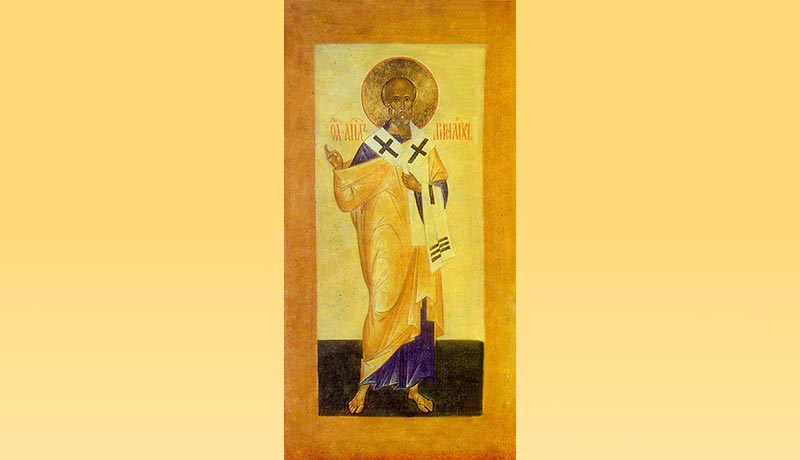
Barnabas
Barnabas ,born Joseph, was an early Christian, one of the prominent Christian disciples in Jerusalem. According to Acts 4:36, Barnabas was a Cypriot Jew. Named an apostle in Acts 14:14, he and Paul the Apostle undertook missionary journeys together and defended Gentile converts against the Judaizers. They traveled together making more converts (c 45–47), and participated in the Council of Jerusalem (c 50) Barnabas and Paul successfully evangelized among the "God-fearing" Gentiles who attended synagogues in various Hellenized cities of Anatolia.
Barnabas' story appears in the Acts of the Apostles, and Paul mentions him in some of his epistles. Although the date, place, and circumstances of his death are historically unverifiable, Christian tradition holds that Barnabas was martyred at Salamis, Cyprus, in 61 AD. He is traditionally identified as the founder of the Cypriot Orthodox Church.
Barnabas is usually identified as the cousin of Mark the Evangelist on the basis of Colossians 4. His Hellenic Jewish parents called him Joseph (although the Byzantine text-type calls him 'Joses', a Greek variant of 'Joseph', but when he sold all his goods and gave the money to the apostles in Jerusalem, they gave him a new name: Barnabas.
Barnabas, a native of Cyprus and a Levite, is first mentioned in the Acts of the Apostles as a member of the early Christian community in Jerusalem, who sold some land that he owned and gave the proceeds to the community (Acts 4:36-37). When the future Apostle Paul returned to Jerusalem after his conversion, Barnabas introduced him to the apostles (9:27).
The successful preaching of Christianity at Antioch to non-Jews led the church at Jerusalem to send Barnabas there to oversee the movement (Acts 11:20–22). He found the work so extensive and weighty that he went to Tarsus in search of Paul (still referred to as Saul), "an admirable colleague", to assist him. Paul returned with him to Antioch and labored with him for a whole year (Acts 11:25–26). At the end of this period, the two were sent up to Jerusalem (44 AD) with contributions from the church at Antioch for the relief of the poorer Christians in Judea.
They returned to Antioch taking John Mark with them, the cousin or nephew of Barnabas. Later, they went to Cyprus and some of the principal cities of Pamphylia, Pisidia, and Lycaonia (Acts 13:14). After recounting what the governor of Cyprus Sergius Paulus believed, Acts 13:9 speaks of Barnabas's companion no longer as Saul, but as Paul, his Roman name, and generally refers to the two no longer as "Barnabas and Saul" as heretofore (11:30; 12:25; 13:2, 7), but as "Paul and Barnabas" (13:43, 46, 50; 14:20; 15:2, 22, 35). Only in 14:14 and 15:12-25 does Barnabas again occupy the first place, in the first passage with recollection of 14:12, in the last 2, because Barnabas stood in closer relation to the Jerusalem church than Paul. Paul appears as the more eloquent missionary (13:16; 14:8-9; 19-20), whence the Lystrans regarded him as Hermes and Barnabas as Zeus.
Returning from this first missionary journey to Antioch, they were again sent up to Jerusalem to consult with the church there regarding the relation of Gentiles to the church (Acts 15:2; Galatians 2:1). According to Galatians 2:9-10, Barnabas was included with Paul in the agreement made between them, on the one hand, and James, Peter, and John, on the other, that the two former should in the future preach to the pagans, not forgetting the poor at Jerusalem. This matter having been settled, they returned again to Antioch, bringing the agreement of the council that Gentiles were to be admitted into the church without having to adopt Jewish practices.
After they had returned to Antioch from the Jerusalem council, they spent some time there (15:35). Peter came and associated freely there with the Gentiles, eating with them, until criticized for this by some disciples of James, as against Mosaic law. Upon their remonstrances, Peter yielded apparently through fear of displeasing them, and refused to eat any longer with the Gentiles. Barnabas followed his example. Paul considered that they "walked not uprightly according to the truth of the gospel" and upbraided them before the whole church (Galatians 2:11-15).
Paul then asked Barnabas to accompany him on another journey (15:36). Barnabas wished to take John Mark along, but Paul did not, as he had left them on the earlier journey (15:37-38). The dispute ended by Paul and Barnabas taking separate routes. Paul took Silas as his companion, and journeyed through Syria and Cilicia; while Barnabas took John Mark to visit Cyprus (15:36-41. Barnabas is not mentioned again in the Acts of the Apostles.
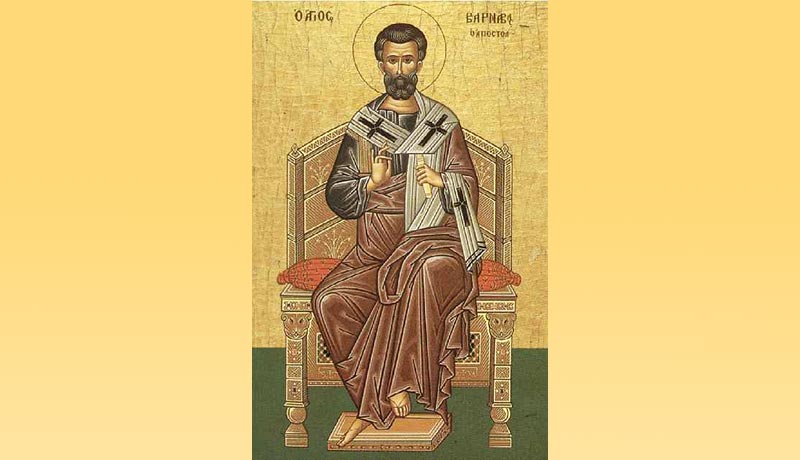
Epaphras
He was a colleague of the Apostle Paul mentioned twice in the New Testament epistle of Colossians and once in the New Testament letter to Philemon. In the first instance he is described as a "fellow servant" (Colossians 1:7) of Paul in his ministry. At the end of the same letter to the Church in Colossae, it is noted that Epaphras is "one of them" and that he sends "greetings" (Colossians 4:12) from his current location to the recipients of the letter. There is a similar refrain in Paul's letter to Philemon, where a person of the same name passes on his "greetings" to Philemon (Philemon 23).
Little is known about him, though we can infer that he was a native of Colossae and that he was perhaps converted by Paul himself during the apostle's ministry in Ephesus. The mention of a co-worker at this point in a Pauline epistle is unusual, and the strength of Paul's endorsement of him is also striking (note also Colossians 4:12-13).
Gaius
A Christian Gaius is mentioned in Macedonia as a traveling companion of Paul, along with Aristarchus (Acts 19:29). One chapter later, a Gaius from Derbe is named as one of Paul's seven traveling companions who waited for him at Troas (Acts 20:4). A Gaius is mentioned residing in Corinth as being one of only a few people there (the others being Crispus and the household of Stephanas) who were baptised by Paul, who founded the Church in that city (1 Corinthians 1:14).
A Gaius is referred to in a final greeting portion of the Epistle to the Romans (Romans 16:23) as Paul's "host" and also host of the whole church, in whatever city Paul is writing from at the time. In all likelihood, this was Corinth.
Lastly, Gaius of Ephesus to whom the third Epistle of John is addressed (3 John 1). He may be one of the men mentioned in any of the other contexts.
Jason of Thessalonica & Sopater or Sosipater
Jason of Thessalonica was a Jewish convert and early Christian believer mentioned in the New Testament in Acts 17:5-9 and Romans 16:21. According to tradition, Jason is numbered among the Seventy Disciples. In Acts 17 his house in Thessalonica was used as a refuge by the apostles Paul, Silas, and Timothy. Non-believing Jews in Thessalonica stirred up a riot and Jason was arrested when the city authorities could not locate Paul nor Silas, and was made to post bail.
Paul referred to Jason, Lucius and Sosipater as his "countrymen" in Romans 16:21, which has led some to call him "Jason of Tarsus" (since Paul was from Tarsus). However, most scholars understand Paul's use of "countryman" here and elsewhere to mean "fellow Jew". Both references to Jason point 'very probably' to the same person. Born in Tarsus, he was appointed Bishop of Tarsus by the Apostle Paul.
Sosipater is a person mentioned in the New Testament, in Romans 16:21. He is probably the same person as Sopater mentioned in Acts 20:4. According to church tradition, he is known as Sosipater of Iconium, and is numbered among the Seventy Apostles. Sosipater was born in Achaea. According to legend, he was Bishop in Iconium (prior to the Apostle Tertius) by his relative the Apostle Paul.
Both apostles traveled to the island of Corfu, where they built a church in honor of the Apostle Stephen the Protomartyr and converted many pagans to the Christian faith. Seeing this, the king of Corfu threw them into prison where they converted seven other prisoners to the Christian faith: Saturninus, Jakischolus, Faustianus, Januarius, Marsalius, Euphrasius and Mammius. The king had those seven put to death for their faith in boiling pitch.
The king's daughter, the virgin Cercyra, having watched these holy apostles being tortured and turned to the Christian faith, distributed all her jewels to the poor. The king became angry and put her in prison, yet she would not deny Christ. So he had the prison burned, but she remained unharmed. Many people were baptized upon seeing this miracle. He then had her killed with arrows while tied to a tree.
Many believers fled to a nearby island to get away from the enraged king, but as he chased them, his boat sank. The new king embraced the Christian faith and in baptism received the name Sebastian. From then on Sosipater and Jason freely preached the Gospel and built up the Church in Corfu until a very old age, when they gave up their souls to God.
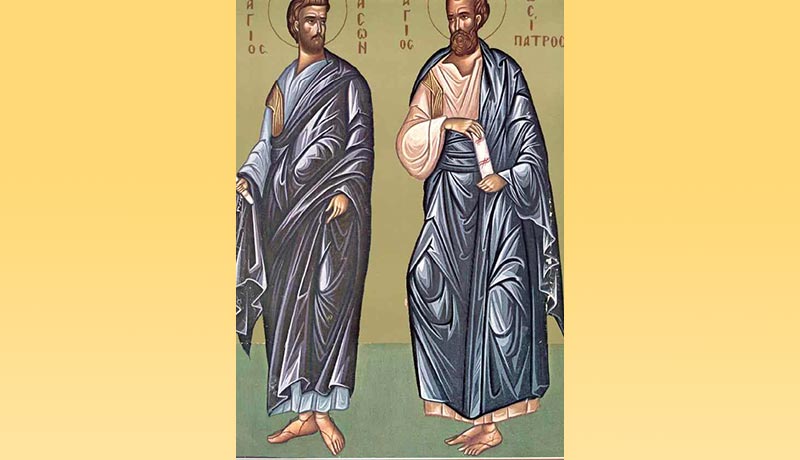
John Mark
John Mark is named in the Acts of the Apostles as an assistant accompanying Paul and Barnabas on their missionary journeys. Traditionally he is regarded as identical with Mark the Evangelist. Several times the Acts of the Apostles mentions a certain "John, who was also called Mark" or simply "John":
When [Peter] realized this, he went to the house of Mary, the mother of John whose other name was Mark, where many were gathered together and were praying. -Acts 12:12
And Barnabas and Saul returned from Jerusalem when they had fulfilled their mission, bringing with them John whose other name was Mark. -Acts 12:25
When they arrived at Salamis, they proclaimed the word of God in the synagogues of the Jews. And they had John to assist them. -Acts 13:5
Now Paul and his company set sail from Paphos, and came to Perga in Pamphylia. And John left them and returned to Jerusalem; but they passed on from Perga and came to Antioch of Pisidia. -Acts 13:13–14
And Barnabas wanted to take with them John called Mark. But Paul thought best not to take with them one who had withdrawn from them in Pamphylia, and had not gone with them to the work. And there arose a sharp contention, so that they separated from each other; Barnabas took Mark with him and sailed away to Cyprus, but Paul chose Silas and departed, being commended by the brethren to the grace of the Lord. -Acts 15:37–40
From these passages it may be gathered that John's mother Mary had a large house in Jerusalem to which Peter fled after escaping prison; that John assisted Paul and Barnabas on their first missionary journey to Cyprus and as far as Perga in Pamphylia, but then returned to Jerusalem; and that later controversy over receiving John Mark back led to Paul and Barnabas parting ways, with Barnabas taking Mark back to Cyprus and both thereafter disappearing from the narrative of Acts.
The reasons for John Mark's departure to Jerusalem and the subsequent disagreement between Paul and Barnabas have been subject to much speculation. Ancient sources in fact consistently distinguish John Mark from the other Marks of the New Testament and style him Bishop of Byblos. Nor was John Mark identified in antiquity with any other John, apart from rare and explicit speculation.
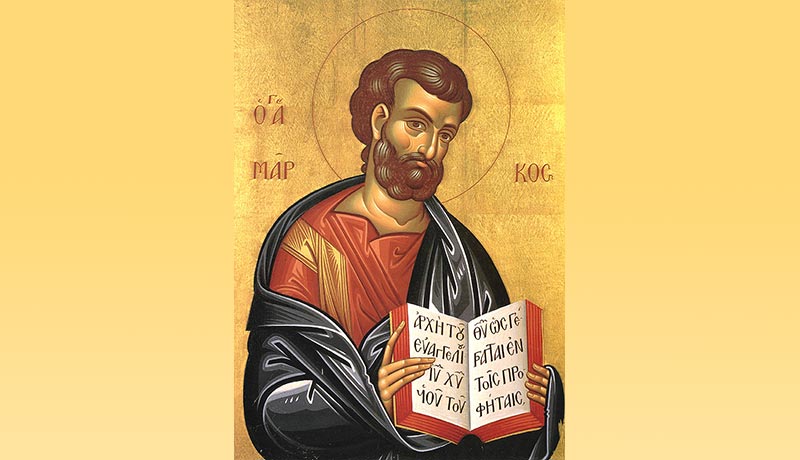
Luke the Evangelist
Luke the Evangelist is one of the Four Evangelists—the four traditionally ascribed authors of the canonical Gospels. The early church fathers ascribed to him authorship of both the Gospel according to Luke and the book of Acts of the Apostles, which would mean Luke contributed over a quarter of the text of the New Testament, more than any other author. Prominent figures in early Christianity such as Jerome and Eusebius later reaffirmed his authorship, although the fragile evidence of the identity of the author of the works has led to discussion in scholarly circles, both secular and religious.
The New Testament mentions Luke briefly a few times, and the Pauline epistle to the Colossians refers to him as a physician (from Greek for 'one who heals'); thus he is thought to have been both a physician and a disciple of Paul. Christians since the faith's early years have regarded him as a saint. He is believed to have been a martyr, reportedly as having been hanged from an olive tree, though some believe otherwise. Many scholars believe that Luke was a Greek physician who lived in the Greek city of Antioch in Ancient Syria, though some other scholars and theologians think Luke was a Hellenic Jew. His earliest notice is in Paul's Epistle to Philemon—Philemon 1:24. He is also mentioned in Colossians 4:14 and 2 Timothy 4:11, two works commonly ascribed to Paul. Luke, was born in Antioch, by profession, was a physician. He had become a disciple of the apostle Paul and later followed Paul until his martyrdom. Having served the Lord continuously, unmarried and without children, filled with the Holy Spirit he died at the age of 84 years.
If we accept that Luke was in fact the author of the Gospel bearing his name and also the Acts of the Apostles, certain details of his personal life can be reasonably assumed. While he does exclude himself from those who were eyewitnesses to Jesus' ministry, he repeatedly uses the word "we" in describing the Pauline missions in Acts of the Apostles, indicating that he was personally there at those times.
There is similar evidence that Luke resided in Troas, the province which included the ruins of ancient Troy, in that he writes in Acts in the third person about Paul and his travels until they get to Troas, where he switches to the first person plural. The "we" section of Acts continues until the group leaves Philippi, when his writing goes back to the third person. This change happens again when the group returns to Philippi. There are three "we sections" in Acts, all following this rule. Luke never stated, however, that he lived in Troas, and this is the only evidence that he did. The composition of the writings, as well as the range of vocabulary used, indicate that the author was an educated man. A quote in the Letter of Paul to the Colossians differentiates between Luke and other colleagues "of the circumcision."
10My fellow prisoner Aristarchus sends you his greetings, as does Mark, the cousin of Barnabas. 11Jesus, who is called Justus, also sends greetings. These are the only Jews among my co-workers for the kingdom of God, and they have proved a comfort to me. … 14Our dear friend Luke, the doctor, and Demas send greetings. -Colossians 4:10–11, 14
This comment has traditionally caused commentators to conclude that Luke was a Gentile. If this were true, it would make Luke the only writer of the New Testament who can clearly be identified as not being Jewish. However, that is not the only possibility. Although Luke is considered likely to be a Gentile Christian, some scholars believe him to be a Hellenized Jew. The phrase could just as easily be used to differentiate between those Christians who strictly observed the rituals of Judaism and those who did not.
Luke's presence in Rome with the Apostle Paul near the end of Paul's life was attested by 2 Timothy 4:11: "Only Luke is with me". In the last chapter of the Book of Acts, widely attributed to Luke, we find several accounts in the first person also affirming Luke's presence in Rome including Acts 28:16: "And when we came to Rome...". According to some accounts, Luke also contributed to the authorship of the Epistle to the Hebrews.
Luke died at age 84 in Boeotia, according to a "fairly early and widespread tradition". According to tradition, Luke's tomb was located in Thebes, whence his relics were transferred to Constantinople in the year 357.
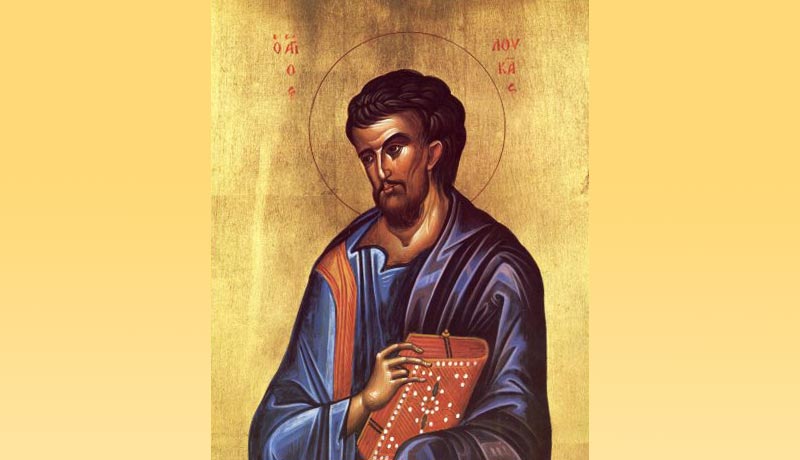
Onesimus
Onesimus, also called Onesimus of Byzantium and The Holy Apostle Onesimus in some Eastern Orthodox churches, was a slave to Philemon of Colossae, a man of Christian faith. He may also be the same Onesimus named by Ignatius of Antioch as Bishop in Ephesus which would put his death closer to 95 A.D. Regardless, Onesimus went from slave to brother to Bishop. The name "Onesimus" appears in two New Testament epistles —in Colossians 4 and in Philemon. In Colossians 4:9 a person of this name is identified as a Christian accompanying Tychicus to visit the Christians in Colossae; nothing else is stated about him in this context. He may well be the freed Onesimus from the Epistle to Philemon.
The Epistle to Philemon was written by Paul the Apostle to the slave-master Philemon concerning a runaway slave called Onesimus. This slave found his way to the site of Paul's imprisonment (most probably Rome or Caesarea) to escape punishment for a theft of which he was accused. After hearing the Gospel from Paul, Onesimus converted to Christianity. Paul, having earlier converted Philemon to Christianity, sought to reconcile the two by writing the letter to Philemon which today exists in the New Testament). The letter reads (in part):
"I appeal to you for my child, Onesimus, whose father I became in my imprisonment. (Formerly he was useless to you, but now he is indeed useful to you and to me.) I am sending him back to you, sending my very heart. I would have been glad to keep him with me, in order that he might serve me on your behalf during my imprisonment for the gospel, but I preferred to do nothing without your consent in order that your goodness might not be by compulsion but of your own accord. For this is perhaps why he was parted from you for a while, that you might have him back forever, no longer as a slave, as a beloved brother—especially to me, but how much more to you, both in the flesh and in the Lord." -Philemon 1:10-16
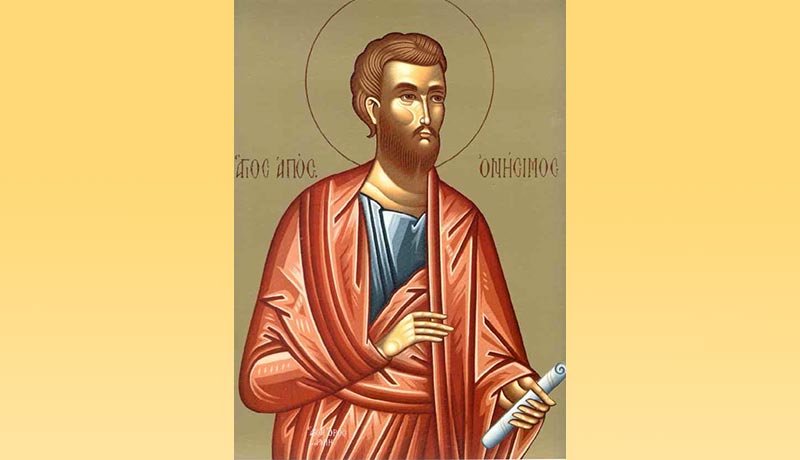
Silas
Silas or Silvanus was a leading member of the Early Christian community, who accompanied Paul the Apostle on parts of his first and second missionary journeys.
Silas is traditionally assumed to be the Silvanus mentioned in four epistles. Some translations, including the New International Version, call him Silas in the epistles. Paul, Silas and Timothy are listed as co-authors of the two letters to the Thessalonians. Second Corinthians mentions Silas as having preached with Paul and Timothy to the church in Corinth (2 Corinthians 1:19) and Peter's first epistle regards Silas as a 'faithful brother' (1 Peter 5:12).
There is some disagreement over the proper form of his name: he is consistently called "Silas" in Acts, but the Latin Silvanus, which means "of the forest", is always used by Paul and in the First Epistle of Peter; it may be that "Silvanus" is the Romanized version of the original "Silas," or that "Silas" is the Greek nickname for "Silvanus." Silas is thus often identified with Silvanus of the Seventy.
Silas is first mentioned in Acts 15:22, where he and Judas Barsabbas (known often as 'Judas') were selected by the church elders to return with Paul and Barnabas to Antioch following the Jerusalem Council. Silas and Judas are mentioned as being leaders among the brothers, prophets and encouraging speakers. Silas was selected by Paul to accompany him on his second mission after Paul and Barnabas split over an argument involving Mark's participation. It was during the second mission that he and Paul were imprisoned briefly in Philippi, where an earthquake broke their chains and opened the prison door. Silas is thus sometimes depicted in art carrying broken chains. Acts 16:25-37.
According to Acts 17-18, Silas and Timothy travelled with Paul from Philippi to Thessalonica, where they were treated with hostility in the synagogues by some traditional Jews. The harassers followed the trio to Berea, threatening Paul's safety, and causing Paul to separate from Silas and Timothy. Paul travelled to Athens, and Silas and Timothy later joined him in Corinth.
These events can be dated to around AD 50: the reference in Acts 18:12 to Proconsul Gallio helps ascertain this date (cf. Gallio inscription). According to Acts 18:6-7, Paul ceased to attend the synagogue in Corinth as a result of Jewish hostility, and it may be inferred that Silas and Timothy did likewise. Silas is not mentioned thereafter in the Acts narrative.
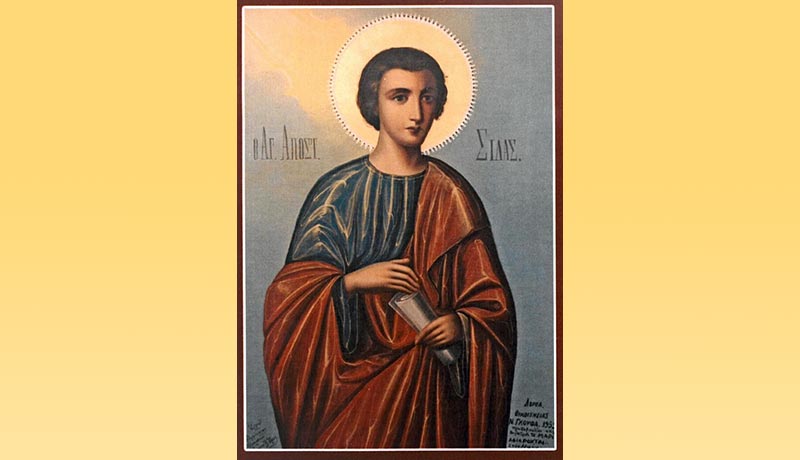
Sosthenes
Sosthenes was the chief ruler of the synagogue at Corinth, who, according to the Acts of the Apostles, was seized and beaten by the mob in the presence of Gallio, the Roman governor, when he refused to proceed against Paul at the instigation of the Jews (Acts 18:12-17). The motives of this assault against Sosthenes are not recorded. Some manuscripts insert the mob was composed of "Greeks"; others read "Jews". Some historians identify this Sosthenes with a companion of Paul the Apostle referred to as "Sosthenes our brother" a convert to the Christian faith and co-author of the First Epistle to the Corinthians (1 Corinthians 1:1-2). It is not clear whether this identification is tenable. He is traditionally listed among the Seventy Disciples.
Trophimus
Trophimus or Trophimus the Ephesian was a Christian who accompanied Paul during a part of his third missionary journey. He was with Paul in Jerusalem, and the Jews, supposing that the apostle had brought him into the temple, raised a tumult which resulted in Paul’s imprisonment. In writing to Timothy, the apostle comments that he left Trophimus in Miletus due to illness. This must refer to some event not noticed in the Acts.
Trophimus and companion Tychicus are called "Asianoi", that is, natives of the Roman province of Asia (Acts 20:4). Making it still more definite, Trophimus is also termed an "Ephesian" and a "Gentile" in Acts 21.
Trophimus was one of eight friends (Acts 20:4), who accompanied Paul at the close of his third missionary journey and traveled with him from Greece, through Macedonia, into Asia, and onward by sea until Jerusalem was reached. Trophimus completed the journey with Paul, for, in the passages Acts 21:29, he is mentioned as being with Paul in Jerusalem immediately on the close of this journey.
He was the innocent cause of Paul being assaulted in the courts of the temple by the Jewish mob, and then of his being arrested and imprisoned by the Romans. The occasion of this outrage was that the Jews supposed that Paul had "brought Greeks also into the temple, and....defiled this holy place" (Acts 21:28). The modicum of fact lying at the root of this false accusation was that they had seen Paul and Trophimus in each other's company in the city. On this slender basis "they supposed" that Paul had brought Trophimus past the barrier or middle wall of partition (Ephesians 2:14), beyond which no Gentile was allowed to penetrate, on pain of death.
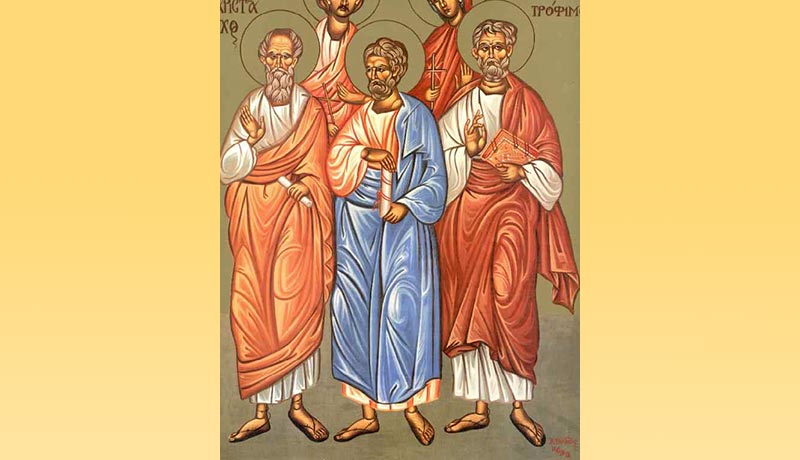
Tychicus
Tychicus was an Asiatic Christian who, with Trophimus, accompanied the Apostle Paul on a part of his journey from Macedonia to Jerusalem. He is also alluded to have been with Paul in Rome, where the apostle sent him to Ephesus, probably for the purpose of building up and encouraging the church there. In the New Testament, he is mentioned five times (Acts 20:4; Ephesians 6:21; Colossians 4:7; Titus 3:12; 2 Timothy 4:12). Acts 20:4 states that Tychicus was from the Roman province of Asia. The Western text indicates that he was an Ephesian.
In Ephesians 6:21, the author (traditionally identified as Paul) calls Tychicus a "dear brother and faithful servant in the Lord" while in Colossians, he says he is "a dear brother, a faithful minister and fellow servant in the Lord."
In both Ephesians and Colossians, the author indicates that he is sending Tychicus to the Christians to whom he is writing, in order to encourage them. The passages in the Epistle to Titus (Titus 3:12) and to Timothy show that Tychicus was again with Paul after the appeal to the emperor had resulted in the apostle regaining his freedom. The passage in Titus evidently refers to the interval between Paul's first and second Roman imprisonments, and while he was again engaged in missionary journeys. The apostle writes to Titus, who was in Crete in charge of the churches there, that he intended to send either Artemas or Tychicus to him, so as to take the oversight of the work of the gospel in that island so that Titus might be free to come to be with the apostle at Nicopolis.
The last passage where Tychicus is mentioned occurs in 2 Timothy, which was written in Rome not long before Paul's execution. To the very end Paul was busy as ever in the work of the gospel; and though it would have been a comfort to him to have his friends beside him, yet the interests of the kingdom of Christ are uppermost in his thoughts, and he sends these friends to help the progress of the work. To the last, Tychicus was serviceable as ever: "Tychicus I sent to Ephesus" (2 Timothy 4:12). As Timothy was in charge of the church in Ephesus (1 Timothy 1:3), the coming of Tychicus would set him free, so as to enable him to set off at once to rejoin Paul at Rome, as the apostle desired him (2 Timothy 4:9, 2 Timothy 4:21).
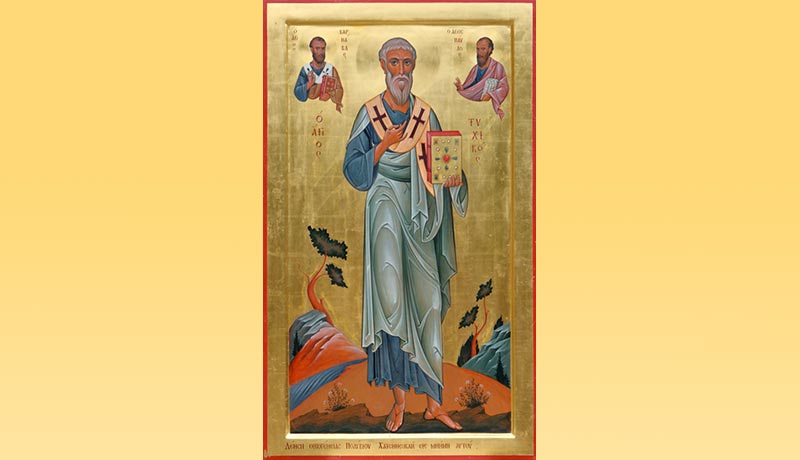
Timothy
Timothy was an early Christian evangelist and the first first-century Christian bishop of Ephesus, who tradition relates died around the year AD 97. Timothy was from the Lycaonian city of Lystra in Asia Minor, born of a Jewish mother who had become a Christian believer, and a Greek father. The Apostle Paul met him during his second missionary journey and he became Paul’s companion and co-worker along with Silas. The New Testament indicates that Timothy traveled with Saint Paul, who was also his mentor. Paul entrusted him with important assignments. He is addressed as the recipient of the First and Second Epistles to Timothy.
Timothy was a native of Lystra in Lycaonia (Anatolia). When Paul and Barnabas first visited Lystra, Paul healed one crippled from birth, leading many of the inhabitants to accept his teaching. When he returned a few years later with Silas, Timothy was already a respected member of the Christian congregation, as were his grandmother Lois and his mother Eunice, both Jews. In 2 Timothy 1:5, his mother and grandmother are noted as eminent for their piety and faith. Timothy is said to have been acquainted with the Scriptures since childhood. In 1 Corinthians 16:10 there is a suggestion that he was by nature reserved and timid: "When Timothy comes, see that you put him at ease among you, for he is doing the work of the Lord".
Timothy's father was Greek, that is, not a Jew. Thus Timothy had not been circumcised and Paul now ensured that this was done, according to the text Acts 16:1–3, to ensure Timothy's acceptability to the Jews whom they would be evangelizing.
Timothy became St Paul’s disciple, and later his constant companion and co-worker in preaching. In the year 52, Paul and Silas took Timothy along with them on their journey to Macedonia. Augustine extols his zeal and disinterestedness in immediately forsaking his country, his house, and his parents, to follow the apostle, to share in his poverty and sufferings. Timothy may have been subject to ill health or "frequent ailments", and Paul encouraged him to "use a little wine for your stomach's sake" (1 Timothy 5:23).
When Paul went on to Athens, Silas and Timothy stayed for some time at Beroea and Thessalonica before joining Paul at Corinth. Timothy next appears in Acts during Paul's stay in Ephesus (54–57), and in late 56 or early 57 Paul sent him forth to Macedonia with the aim that he would eventually arrive at Corinth. Timothy arrived at Corinth just after 1 Corinthians reached that city. The letter was not well received, and Timothy quickly returned to Ephesus to report this to Paul.
Timothy was with Paul in Corinth during the winter of 57–58 when Paul dispatched his Letter to the Romans (Romans 16:21). According to Acts 20:3–6, Timothy was with Paul in Macedonia just before Passover in 58; he left the city before Paul, going ahead of him to await Paul in Troas (Acts 20:4–5). "That is the last mention of Timothy in Acts", Raymond Brown notes. In the year 64, Paul left Timothy at Ephesus, to govern that church.
His relationship with Paul was close and Paul entrusted him with missions of great importance. Timothy's name appears as the co-author on 2 Corinthians, Philippians, Colossians, 1 Thessalonians, 2 Thessalonians, and Philemon. Paul wrote to the Philippians about Timothy, "I have no one like him" (Philippians 2:19–23). When Paul was in prison and awaiting martyrdom, he summoned his faithful friend Timothy for a last farewell.
That Timothy was jailed at least once during the period of the writing of the New Testament is implied by the writer of Hebrews mentioning Timothy's release at the end of the epistle.

Other Persons Mentioned In The Acts
Ananias of Damascus
Ananias was a disciple of Jesus at Damascus mentioned in the Acts of the Apostles in the Bible, which describes how he was sent by Jesus to restore the sight of "Saul, of Tarsus".
According to Acts 9:10, Ananias was living in Damascus. In Paul's speech in Acts 22, he describes Ananias as "a devout man according to the law, having a good report of all the Jews" that dwelt in Damascus (Acts 22:12).
During his conversion experience, Jesus had told Saul (who was then called Paul) to go into the city and wait. Jesus later spoke to Ananias in a vision, and told him to go to the "street which is called Straight", and ask "in the house of Judas for one called Saul, of Tarsus". (Acts 9:11) Ananias objected that Saul had been persecuting "thy saints", but the Lord told him that Saul was "a chosen vessel unto me, to bear my name before the Gentiles, and kings, and the children of Israel". (Acts 9:15). When Ananias went in to Saul and laid his hands on him, the "scales" of dead tissue on the surface of his eyes fell off, and he looked up at Ananias. After additional instruction, Saul was baptized. (Acts 9:18; 22:16)
According to tradition, Ananias was martyred in Eleutheropolis.
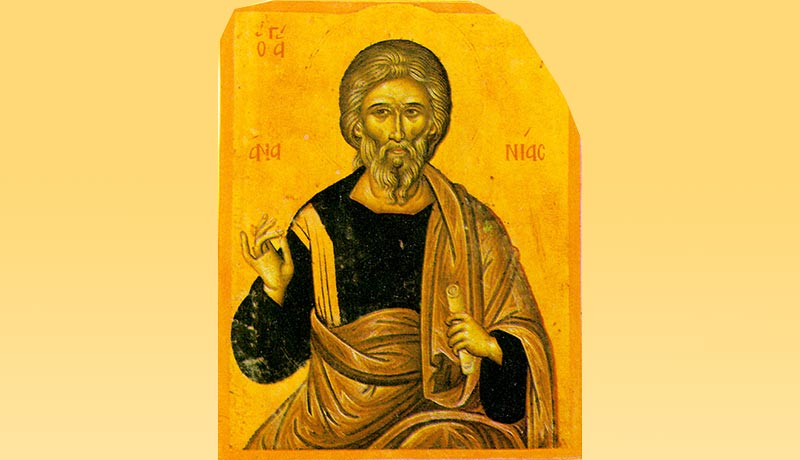
Damaris
Damaris is the name of a woman mentioned in a single verse in Acts of the Apostles (17:34) as one of those present when Paul of Tarsus preached in Athens in front of the Athenian Areopagus in c. AD 55. Together with Dionysius the Areopagite she embraced the Christian faith following Paul's speech.
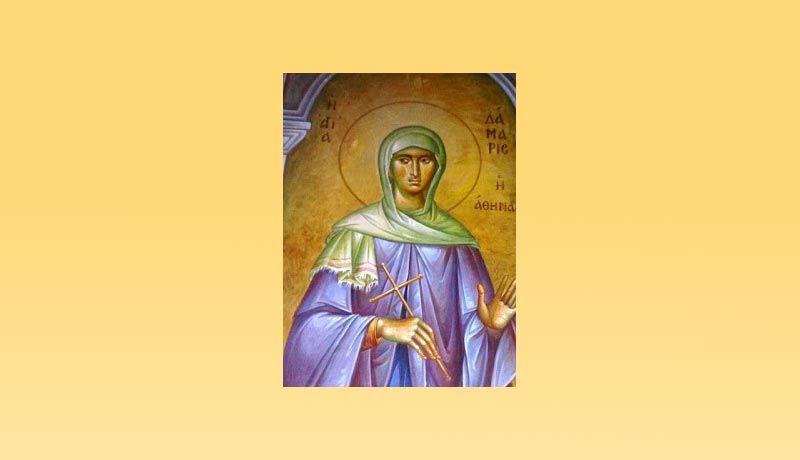
Dionysius the Areopagite
Dionysius the Areopagite was a judge at the court Areopagus in Athens who lived in the first century AD. As related in the Acts of the Apostles, (Acts 17:34), he was converted to Christianity by the preaching of the Apostle Paul during the Areopagus sermon. According to Dionysius of Corinth, quoted by Eusebius, this Dionysius then became the first Bishop of Athens.
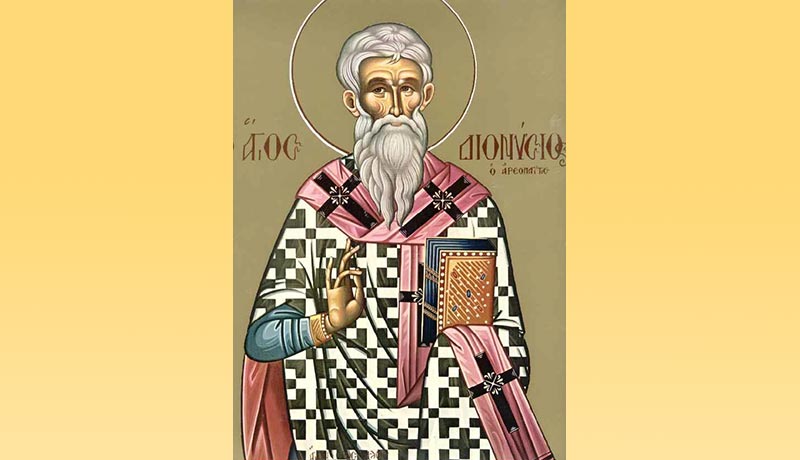
Erastus of Corinth
Erastus, also known as Erastus of Paneas, is a person in the New Testament. According to the Epistle to the Romans, Erastus was a steward in Corinth, a political office of high civic status. The word is defined as "the manager of household or of household affairs" or, in this context, "treasurer"; The King James Version uses the translation "chamberlain", while the New International Version uses "director of public works". A person named Erastus is also mentioned in the 2 Timothy and Acts, and these mentions are usually taken to refer to the same person.
According to the tradition of the Orthodox Church, Erastus is numbered among the Seventy Disciples. He served as a deacon and steward of the Church at Jerusalem and later of Paneas in Palestine. In 1929, an inscription mentioning an Erastus was found near a paved area northeast of the theater of Corinth. It has been dated to the mid-first century and reads "Erastus in return for his aedileship paved it at his own expense." (Latin: ERASTVS. PRO. AED. S. P. STRAVIT, abbreviated for ERASTUS PRO AEDILITATE SUA PECUNIA STRAVIT.) New Testament scholars have identified this aedile Erastus with the Erastus mentioned in The Epistle to the Romans but this is in dispute. This debate has implications relating to the social status of the members of the Pauline churches.
Gamaliel
The Acts of the Apostles introduces Gamaliel as a Pharisee and celebrated doctor of the Mosaic Law in Acts 5:34–40. In the larger context (vs.17–42), Peter and the other apostles are described as being prosecuted before the Sanhedrin for continuing to preach the gospel despite the Jewish authorities having previously prohibited it. The passage describes Gamaliel as presenting an argument against killing the apostles, reminding them about the previous revolts of Theudas and Judas of Galilee, which had collapsed quickly after the deaths of those individuals. Gamaliel's advice was accepted after his concluding argument:
"And now I say unto you, Refrain from these men, and let them alone: for if this counsel or this work be of men, it will come to nought: But if it be of God, ye cannot overthrow it; lest haply ye be found even to fight against God." —Acts 5:38–39
The Book of Acts later goes on to describe Paul the Apostle recounting that although "born in Tarsus", he was brought up in Jerusalem "at the feet of Gamaliel, [and] taught according to the perfect manner of the law of the fathers" (Acts 22:3). No details are given about which teachings Paul adopted from Gamaliel, as it is assumed that as a Pharisee, Paul was already recognized in the community at that time as a devout Jew. Also, how much Gamaliel influenced aspects of Christianity is unmentioned. However, there is no other record of Gamaliel ever having taught in public, but the Talmud does describe Gamaliel as teaching a student who displayed "impudence in learning", which a few scholars identify as a possible reference to Paul.
The relationship of Paul the Apostle and Judaism continues to be the subject of scholarly debate. Helmut Koester, Professor of Divinity and of Ecclesiastical History at Harvard University, questions if Paul studied under this famous rabbi, arguing that there is a marked contrast in the tolerance that Gamaliel is said to have expressed about Christianity with the "murderous rage" against Christians that Paul is described as having prior to his conversion (Acts 8:1–3). In the apocryphal Gospel of Gamaliel, he figures as a witness to the raising of a dead man at Jesus' tomb.
Lydia of Thyatira
Lydia of Thyatira is a woman mentioned in the New Testament who is regarded as the first documented convert to Christianity in Europe. The name, "Lydia", meaning "the Lydian woman", by which she was known indicates that she was from Lydia in Asia Minor. Though she is commonly known as “St. Lydia” or even more simply “The Woman of Purple,” Lydia is given other titles: “of Thyatira,” “Purpuraria,” and “of Philippi (‘Philippisia’ in Greek).” “[Lydia’s] name is an ethnicon, deriving from her place of origin”.The first refers to her place of birth, which is a city in the Greek region of Lydia. The second comes from the Latin word for purple and relates to her connection with purple dye. Philippi was the city in which Lydia was living when she met St. Paul and his companions. All of these titles expound upon this woman’s background.Acts 16 describes Lydia as follows:
A certain woman named Lydia, a seller of purple, of the city of Thyatira, one who worshiped God, heard us; whose heart the Lord opened to listen to the things which were spoken by Paul. When she and her household were baptized, she begged us, saying, "If you have judged me to be faithful to the Lord, come into my house, and stay." So she persuaded us. -Acts 16:14-15
Lydia was most likely a Greek even though she lived in a Roman settlement. She was evidently a well-to-do agent of a purple-dye firm in Thyatira, a city southeast of Pergamum and approximately 40 miles inland, across the Aegean Sea from Athens. Lydia insisted on giving hospitality to Saint Paul and his companions in Philippi. They stayed with her until their departure, through Amphipolis and Apollonia, to Thessalonica (Acts 16:40-17:1).
Paul, Silas, and Timothy were traveling through the region of Philippi when they encounter "a reputable businesswoman and possibly a widow… [who] was a righteous Gentile or 'God-fearer' attracted to Judaism"."[S]he was one of a large group [considered]… sympathizers with Judaism, believers in the one God, but who had not yet become 'proselytes' or taken the final step to conversion to Judaism". Because these encounters and events take place "in what is now Europe", Lydia is considered "the first 'European' Christian convert".
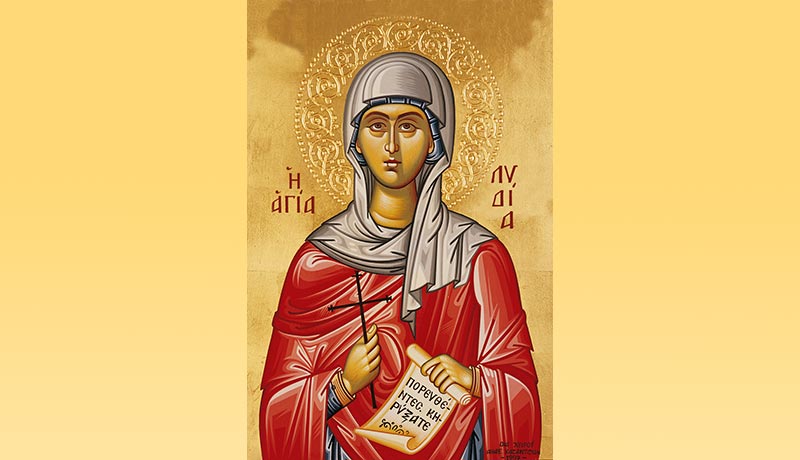
Priscilla and Aquila
Priscilla and Aquila were a first century Christian missionary married couple described in the New Testament and traditionally listed among the Seventy Disciples. They lived, worked, and traveled with the Apostle Paul, who described them as his "fellow workers in Christ Jesus" (Romans 16:3 ).
Priscilla and Aquila are described in the New Testament as providing a presence that strengthened the early Christian churches. Paul was generous in his recognition and acknowledgment of his indebtedness to them (Rom. 16:3-4). Together, they are credited with instructing Apollos, a major evangelist of the first century, and "[explaining] to him the way of God more accurately" (Acts 18:26).
They are mentioned six times in four different books of the New Testament, always named as a couple and never individually. Of those six references, Aquila's name is mentioned first three times and Priscilla's name is mentioned first on three occasions This may indicate their equal status.
The Christian Church, beginning with Jesus, had a radical view of the status of women. Jesus demonstrated that he valued women and men equally as being made in the image of God. Luke clearly indicates Priscilla’s "agency and her interdependent relationship with her husband. She is certainly not Aquila’s property - as was customary in Greco-Roman society - but rather his partner in ministry and marriage".
Priscilla and Aquila were tentmakers as was Paul. Priscilla and Aquila had been among the Jews expelled from Rome by the Roman Emperor Claudius in the year 49 as written by Suetonius. They ended up in Corinth. Paul lived with Priscilla and Aquila for approximately 18 months. Then the couple started out to accompany Paul when he proceeded to Syria, but stopped at Ephesus in the Roman province of Asia, now part of modern Turkey.
In 1 Corinthians 16:19, Paul passes on the greetings of Priscilla and Aquila to their friends in Corinth, indicating that the couple were in his company. Paul founded the church in Corinth.[1 Cor. 4:15] His including them in his greetings implies that Priscilla and Aquila were also involved in the founding of that church. Since 1 Corinthians discusses a crisis deriving from a conflict between the followers of Apollos and the followers of Cephas (possibly the apostle Peter), it can be inferred that Apollos accompanied Priscilla and Aquila when they returned to Corinth. This happened before 54, when Claudius died and the expulsion of the Jews from Rome was lifted.
In Romans 16:3-4, thought to have been written in 56 or 57, Paul sends his greetings to Priscilla and Aquila and proclaims that both of them "risked their necks" to save Paul's life.
Tradition reports that Aquila and Priscilla were martyred together.
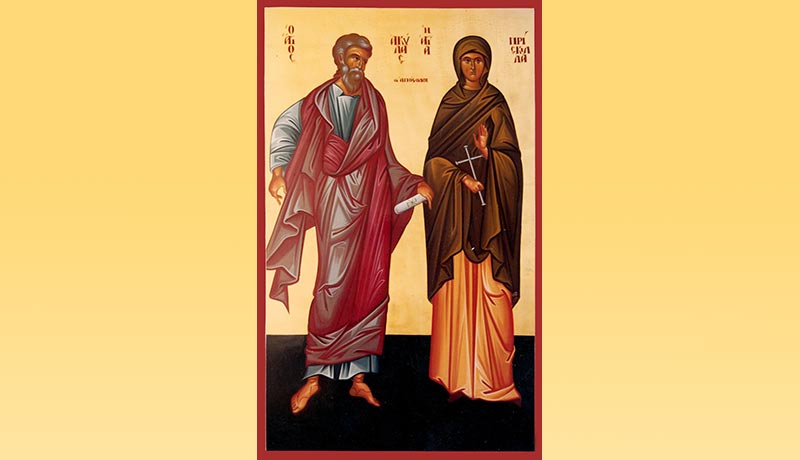
Philemon
Philemon was an early Christian in Asia Minor who was the recipient of a private letter from Paul of Tarsus. This letter is known as Epistle to Philemon in the New Testament. He is known as a saint by several Christian churches along with his wife Apphia. Philemon was a wealthy Christian and a minister of the house church that met in his home.
The Menaia of 22 November speak of Philemon as a holy apostle who, in company with Apphia, Archippus, and Onesimus had been martyred at Colossae during the first general persecution in the reign of Nero.
In the list of the Seventy Apostles, attributed to Dorotheus of Tyre, Philemon is described as bishop of Gaza.
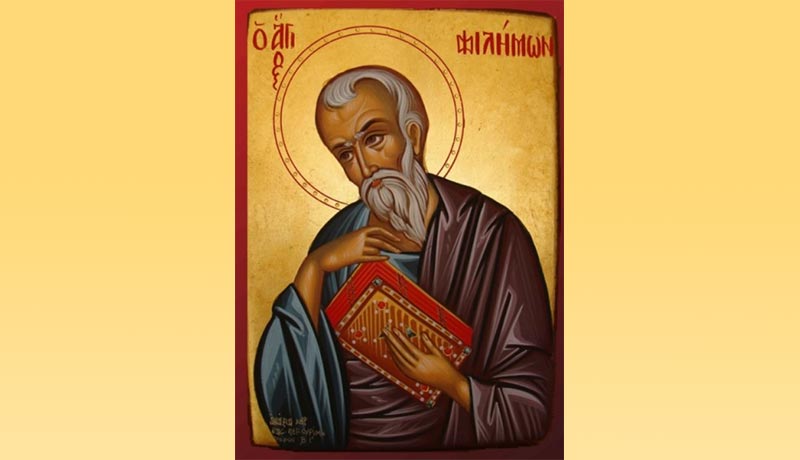
Theophilus
Theophilus is the name or honorary title of the person to whom the Gospel of Luke and the Acts of the Apostles are addressed (Luke 1:3, Acts 1:1). It is thought that both Luke and Acts were written by the same author, and often argued that the two books were originally a single unified work.
Both Luke and Acts were written in a refined Koine Greek, and the name "Theophilos", as it appears therein, means friend of God or (be)loved by God or loving God in the Greek language. No one knows the true identity of Theophilus and there are several conjectures and traditions around an identity.
In English Theophilus is also written "Theophilos", both a common name and an honorary title among the learned (academic) Romans and Jews of the era. The life of Theophilus would coincide with the writing of Luke and the author of the Acts.


